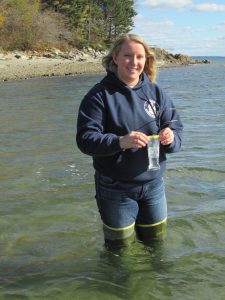Best of Both Worlds
Master’s student and marine resource scientist Hannah Horecka divides her time between UMaine and the state’s Department of Marine Resources
Hannah Horecka graduated from UMaine in 2012 with a Bachelor’s degree in Marine Science. A student in the Honor’s College, Horecka’s honor’s thesis was on biotoxin trends (such as red tide) in Cobbscook Bay—research that helped land her a contract position at the Maine Department of Marine Resources (DMR) shortly after graduating and a job as a staff scientist in 2015.
In January 2018, Horecka circled back to UMaine as a Master’s student in the School of Earth and Climate Sciences and began taking graduate courses—her first being a hydrology class taught by associate professor Sean Smith of the School of Earth & Climate Sciences and the Mitchell Center. She is working with Smith, now her advisor, on a larger project regarding land-sea interactions in coastal pollution.

Like Horecka, Smith had one foot in academia and one in a state environmental agency from his time as an undergraduate and master’s student at the University of Maryland through his Ph.D. work at Johns Hopkins. And he strongly believes Horecka will benefit from straddling both worlds.
“It’s a great way to hone in on real-world problems and real technical issues,” Smith says. “You’re in the middle of it all as opposed to sitting on the sidelines until you graduate. I can’t say enough about it.”
Says Horecka, “Without any real-world work experience it’s easy to overlook coursework you later realize you should have paid attention to. For example, as an undergraduate, there were things I thought would be incredibly important with my career goals in mind but I don’t use as much in this position.” She adds, “Now, as a graduate student, I know what I need to concentrate on to use in my position as a DMR marine resource scientist.”
At DMR, Horecka manages the shellfish flats—mussels, oysters, clams, and quahogs—from Stockton Springs to Schoodic Point.
“My job is to take the data and determine if they meet the standards for shellfish harvest to see if they’re safe for human consumption,” says Horecka. She looks mostly for fecal bacteria, E. coli specifically. “However,” she adds, “we do also manage around oil spills, heavy metals, contaminants from industrial activities, and other deleterious substances.”
